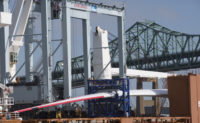
Statoil, developer of the world’s first full-scale floating wind turbine, is reporting good performance on its 2.3-MW test project near the North Sea. The Norwegian company is targeting the Gulf of Maine as a site for a 12-MW floating-turbine test wind farm, despite the tough U.S. environment for wind-energy development. If constructed, this would be the first floating wind turbine farm in the U.S.
“We chose the coast of Maine because of good wind conditions, deep waters and proximity to electricity load centers—good options for onshore infrastructure connections” with the New England electrical grid, says Morton Eek, spokesman for Statoil’s renewable-energy division.
In a related development, Seattle-based Principle Power and Energias de Portugal (EDP) recently reported that they successfully have deployed a 2.0-MW deepwater turbine called WindFloat by towing the unit 215 miles and installing it at a site six miles off the coast of Agucadoura, Portugal. The anchored, semisubmersible floating design is reported to be the first floating wind turbine platform in the open waters of the Atlantic Ocean.
In October, Statoil North America submitted its bid for a commercial lease in U.S. federal waters to the Bureau of Ocean Energy Management; the project is now under review. On Dec. 8, a BOEM Maine Renewable Energy Task Force met in Portland, Maine, to discuss the project.
The BOEM meeting occurred four days before NRG Energy announced it was closing its Princeton, N.J., office and putting its offshore wind development projects on hold in Delaware, New Jersey, Maryland and Massachusetts due to “monumental challenges in developing a new domestic industry.” Bluewater Wind, NRG’s subsidiary and lead developer of the Mid-Atlantic Wind Park off the coast of Delaware, has been unable to find an investment partner and intends to terminate the project’s 200-MW power purchase agreement with the Delmarva Power & Light Co. at the end of the year, a company statement notes.
Meanwhile, Eek says Statoil’s 2.3-MW floating wind turbine—called Hywind and located 6.2 miles off the southwest coast of Norway—has survived harsh conditions, including recent stormy weather in the North Sea. Its annual wind production capacity is 50%, compared with 20% to 30% for typical onshore wind-turbine capacity. The firm is now focusing on optimizing cost and stimulating supply-chain investment, Eek says. The firm selected the Maine site following a feasibility study performed in collaboration with the University of Maine. Statoil plans to continue its study for another two and a half years to verify its findings, Eek says. Statoil also is considering a floating wind turbine site in Scotland.
The four turbine wind farms would be located 12 nautical miles offshore near Boothbay, Maine, where waters range in depth from 140 meters to 160 m, or 459 ft to 525 ft, Eek says. The exact location of the turbines will be determined next, he says.
Ken Fletcher, director of the Maine energy office of Gov. Paul LePage (R), says Statoil is one of a few bidders who submitted renewable-energy proposals to the Maine Public Utilities Commission in September. These schemes were in response to the commission’s request for proposals for such projects.
Habib Dagher, director of the Advanced Structures and Composites Center at the University of Maine, says the university signed a cooperative agreement with Statoil in 2009 to work on deepwater technologies. “The goal is to work together on floating wind-turbine technologies and applications in the U.S.,” he says. In one cooperative project, “we looked at how we could adapt use of Hywind technology on the Gulf of Maine,” he says. University of Maine researchers are continuing to work closely with Statoil on siting, environmental issues and consideration of ports for set up and deployment. “Once a project gets under way, I expect investments in assembly facilities will follow,” Dagher says.
Port space and support infrastructure are available for an assembly and staging area at the Searsport Terminal at Mack Point in the upper regions of Penobscot Bay, according to a Maine Deepwater Offshore Wind Report published in February. Nearby, Sears Island has space that could be developed for larger projects. Additional port infrastructure and industrial waterfront real estate is available farther up the Penobscot River and in the surrounding Penobscot Bay area, the report notes. In addition, a deepwater area in the upper east side of Penobscot Bay could serve as a wet assembly and ballast area, and a nearby deepwater route would allow deployment access out of the bay, it notes.





